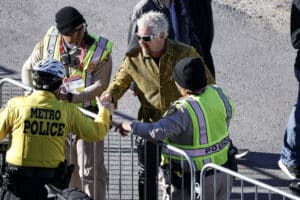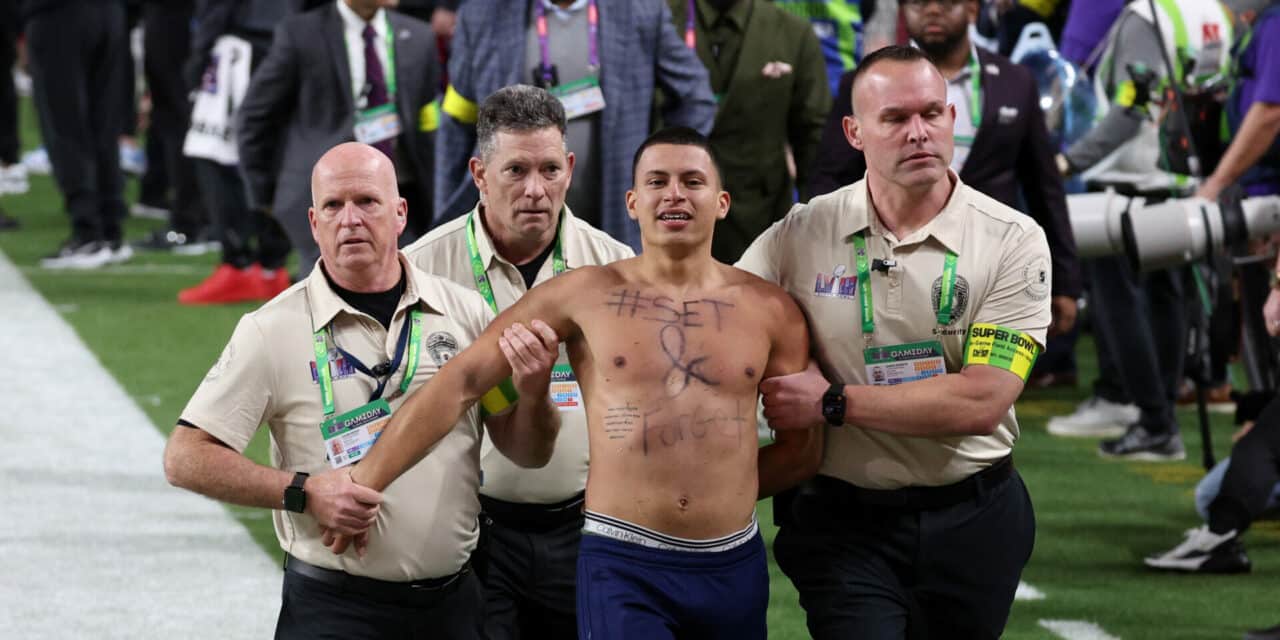BUSTED IN VEGAS: Security officials grab a man at Allegiant Stadium after he illegally ran onto the field during Super Bowl LVIII. (Getty Images)
New effort to ID illegal sports betting inside league
HOLLYWOOD, Florida — The NFL has upgraded its accreditation system to simplify the process for determining on-field access and other restricted spaces across the league’s 30 stadiums.
Andrea Schultz, the NFL’s director of strategic security programs, discussed the new system at the Stadium Managers Association seminar on Feb. 13, as well as the league’s effort to flag illegal sports betting inside the ranks of the 32 teams.
The league has put greater emphasis on eliminating the complexity of credentialing of all personnel tied to stadium operations on game days, which has been a confusing issue for everybody, according to Schultz.
For the 2024 season, the NFL plans to roll out a new centralized credential system league-wide, tied to facial recognition software that’s more efficient and effectively consolidates the multiple numbers and symbols attached to game badges.
When credential badges containing the person’s digital photo and a bar code is scanned, the technology compares it to a real-time photo taken of the individual at the security checkpoint. In turn, the process triggers the scanner to turn green or red, which determines whether the person has access to the space in question.
In addition to simplifying the process, it helps better identify fake credentials, which have proliferated over time, Schultz said.
The improvements come after six teams participated in a pilot program last season using facial notification, providing feedback on the pros and cons of those tests. The Cleveland Browns were one of the teams involved in the pilot, using technology developed by Wicket, a company owned in part by the Haslam family, the Browns’ ownership group. (Cleveland and Atlanta were two NFL teams also testing facial notification for fan entry).
The new system was also tested at Super Bowl LVIII.
“We started this project 3.5 years ago and it’s finally coming to fruition,” Schultz said. “The pilot was the first step in learning, and we still have a lot of learning to do.”
Schultz showed a display of multiple NFL badges on a big screen that were mostly a jumble of symbols and colors that only “someone with a degree in rocket science could decipher,” she said.
“I showed up in Las Vegas, got a credential and there were 18 letters, colors and shapes,” Schultz said. “What does it all mean and why is my lanyard green vs. yellow? Two of my colleagues are color blind and they couldn’t see half of what was going on with the badges.”

I KNOW A GUY: Restaurateur and TV personality Guy Fieri greets accredited law enforcement on Super Bowl Sunday in Las Vegas. (Getty Images)
The new system will hopefully clear up the complications and make things much easier, both for part-time workers thrown in the mix to work game days and those people involved in the scanning process.
“We have a phone next to the scanner, where you can call up credential control and say, ‘I’m supposed to be green right now, but am scanning red. We can instantaneously identify if there’s a glitch in the system,” Schultz said. “It (worked) amazing at Super Bowl. It empowers the staff standing there saying no to this person who’s saying, ‘Don’t you know who I am and why I’m supposed to be here?’ The reality is they don’t know who you are or what your function is. But if your badge shows red, you can use the phone and they’ll fix it for you.”
The fake credentials spotted by NFL officials are mostly badges that people print at home and game day workers are encouraged not to wear their credentials in public outside of the event to avoid scammers from stealing their identity and taking photos of badges on the street, she said.
“What we try to do at Super Bowl is touch every credential and train people what it should feel like,” Schultz said. “My Signal app (for instant messaging) was blowing up all day long with reports of people with fake credentials. I kept asking myself, ‘Are there more fake credentials or are we just catching more of them?’ The answer was that we’re catching more.”
Schultz also touched on the NFL’s “integrity representatives,” whose job on game days across the league is to search for behavioral patterns that could potentially lead to illegal sports betting on the part of players and coaches.
Their task takes on greater significance after two particular incidents this past season involving a person loosely connected to the University of Michigan football team who was illegally recording video of Wolverines opponents during games at other schools, and a Jacksonville Jaguars executive who stole $20 million in team funds to pay gambling debts and was eventually fired from the team.
In addition, with sports betting now legal in about 40 states, the gambling issue poses a greater threat to the integrity of the game across all sports.
“You have to take a look at what’s happening on the field,” Schultz said. “We now have these personnel that work all the games. They have a checklist, looking for various things that might signal that maybe a coach is doing something they’re not supposed to be doing, or maybe a guy in the press box is recording something. It’s happening out there and it’s key for us to protect the product coming out.”







